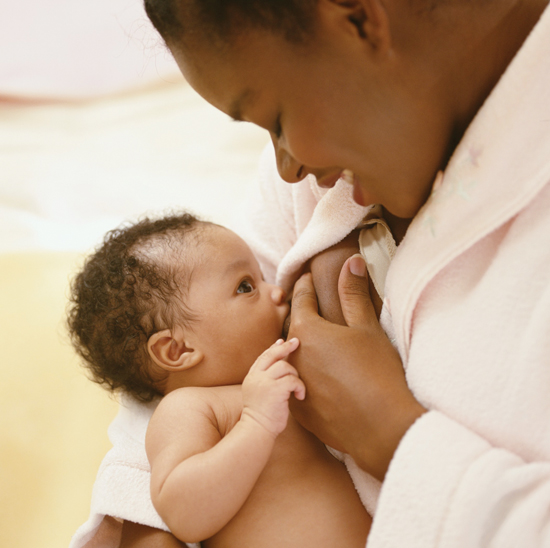8.3 Development and Plasticity of the Visual System
“Seeing” is some that is spontaneous and automatic. You don’t seem to expend any mental effort “seeing,” it just happens. You certainly don’t “learn” to see, at least the way learning is typically thought of. But as it turns out, some experience is necessary for vision. We may not learn to see the way a rat learns its way through a maze or the way children learn to behave when in public, but it is also not fully automatic, at least not initially.
Vision at Birth
10
How can we tell what an infant sees? What methods can be used to determine visual acuity in young babies?
No one knows for certain what human newborns see, but we can tell how well they see. For example, we know that the lenses of the eyes of newborns do not adjust (or accommodate) very much, meaning that most of what a newborn sees is out of focus (Tondel & Candy, 2008). The lens is relatively fixed so that objects are most clearly seen when they are about 20 to 25 cm (about 8 to 10 inches) from their eyes, which corresponds about to the distance between an infant’s face and that of his or her mother during nursing. Also, convergence (both eyes looking at same object) and coordination (both eyes following a moving stimulus in a coordinated fashion) are poor at birth, but each develops rapidly and is adult-like by 6 months of age (Aslin & Jackson, 1979). Even when a newborn looks at a stationary stimulus at the “right” distance, its visual acuity—the ability to see clearly—is poor (Kellman & Banks, 1998).
How can one tell how clearly a newborn sees? One technique is to show babies striped patterns like the one in Figure 8.11. If infants look at the striped rectangle longer than at a plain gray rectangle, researchers know they can tell the difference, or discriminate, between them. Researchers assess the infants’ ability to discriminate by progressively displaying patterns with the stripes closer and closer together. When infants no longer look more at the striped rectangle relative to the solid gray one, this indicates that they cannot discriminate between them. While normal acuity for adults is 20/20 (one can see at a distance of 20 feet what a person with “normal” vision can see at 20 feet), estimates of newborn acuity range from 20/400 to 20/600 (Slater, 1995). This would make newborns legally blind in most states. Acuity improves substantially during the first year of life, although it does not reach adult levels until about 6 years of age (Skoczenski & Norcia, 2002; Kellman & Arterberry, 2006).


The visual system of newborns is obviously far from what it will become, but if two stimuli are sufficiently different from one another, even newborns will be able to “see” them and tell them part. We know this because infants who are shown a visual stimulus decrease their looking time as a result of repeated presentation of that stimulus (this is an example of habituation, discussed in Chapter 4). When they are then shown a new stimulus, they will increase their looking time to that stimulus. If they do this, it indicates that the infants can tell the difference between the two stimuli and have at least a very brief memory for the original stimulus. Using procedures such as this, newborns have been shown to discriminate between two highly discrepant stimuli, such as bull’s-eye and checkerboard patterns (Friedman, 1972; Slater, 1995).
292
Is “Experience” Necessary to See?
11
What are experience-expectant processes, and how do they relate to the development of vision?
The visual abilities of newborns improve substantially over the first several months of life, but this does not allow us to conclude that experience is a necessary factor in the ability to see. Perhaps all that is needed is a certain level of neurological maturation. In fact, there is evidence that the brain is prepared to make sense of visual information, but that it must receive the proper stimulation to get hooked up properly.
William Greenough and his associates (Black et al., 1998; Greenough et al., 1987) proposed that the nervous system of animals has been prepared by natural selection to expect certain types of stimulation, such as a three-dimensional visual world consisting of moving objects. Greenough and his colleagues referred to the processes whereby synapses are formed and maintained when an organism has species-typical experiences as experience-expectant processes (or experience-expectant synaptogenesis); as a result, functions—in this case vision—will develop for all members of a species, given a species-typical environment.
But, if that species-typical environment is absent, the animal may not develop normal vision. For instance, when rats or cats are raised in total darkness, they later have difficulty making even simple visual discriminations (Crabtree & Riesen, 1979). Experience with patterned light is necessary for the brain to be able to make sense of the light stimulation falling on the retina. Something similar seems to happen to human adults who have cataracts removed. Shortly after surgery, they can tell the difference between a square and a triangle only by counting the corners (Von Senden, 1960). Visual abilities for once-deprived animals and humans improve with time, although the longer the period of deprivation, the less reversible are the effects (Crabtree & Riesen, 1979; Timney et al., 1980).
When kittens first open their eyes, about half of the neurons in the visual cortex respond selectively to direction of movement or orientation of a stimulus—that is, they fire only when an object in their visual field moves in a certain direction or is in a particular orientation, such as diagonal lines or straight lines. (We’ll have more to say about feature detection later in the chapter.) After several weeks of normal visual experience, all the cells in the visual cortex become sensitive to the orientation of a stimulus or to direction of movement. These cells “expected” to receive visual input and thus developed “normally” with “normal” experience. However, when kittens were deprived of visual experience immediately after opening their eyes, they gradually lost their sensitivity to orientation. Experience (or lack of experience) changed the structure and organization of their brains. Recovery of normal neuronal structure and responsivity following exposure to patterned light occurs, although the degree of recovery declines with longer periods of deprivation (Blakemore & Van Sluyters, 1975; Cynader et al., 1976).
Of course, experimenters cannot deprive human infants of light as has been done with laboratory animals. However, Daphne Maurer and her colleagues have done research with infants born with cataracts over their eyes, some of whom had them removed shortly after birth (Le Grand et al., 2001; Maurer et al., 2007; Maurer et al., 1999). The researchers reported that infants who had cataracts removed and new lenses placed in their eyes within several months of birth showed a generally typical pattern of visual development. The longer the delay in removing the cataracts, however, the poorer their vision was. Moreover, even for those babies who had cataracts removed early, some aspects of face processing were impaired (Le Grand et al., 2001). This finding suggests that there may be different sensitive periods for the brain areas associated with visual acuity and those associated with processing faces. It also points to the importance of identifying and correcting visual problems early to minimize their long-term effects.
293
SECTION REVIEW
Experience is necessary for vision to develop properly.
Vision at birth
- Vision is poor at birth, although newborns can see most clearly objects that are about 8 to 10 inches from their face, about the distance between an infant’s face and that of his or her mother during nursing.
- Using infants’ looking time, researchers can determine if newborns can discriminate between two visual stimuli.
The Influence of Experience on Vision
- The visual nervous system is prepared for certain types of visual experiences, such as three-dimensional objects, and will development normally given a species-typical environment.
- When young animals or children fail to receive species-typical experiences, as a result of cataracts, for example, vision does not development normally.